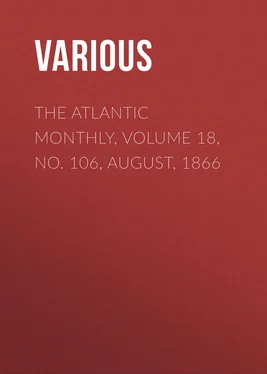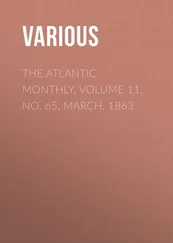Various - The Atlantic Monthly, Volume 18, No. 106, August, 1866
Здесь есть возможность читать онлайн «Various - The Atlantic Monthly, Volume 18, No. 106, August, 1866» — ознакомительный отрывок электронной книги совершенно бесплатно, а после прочтения отрывка купить полную версию. В некоторых случаях можно слушать аудио, скачать через торрент в формате fb2 и присутствует краткое содержание. Жанр: foreign_antique, periodic, foreign_edu, на английском языке. Описание произведения, (предисловие) а так же отзывы посетителей доступны на портале библиотеки ЛибКат.
- Название:The Atlantic Monthly, Volume 18, No. 106, August, 1866
- Автор:
- Жанр:
- Год:неизвестен
- ISBN:нет данных
- Рейтинг книги:3 / 5. Голосов: 1
-
Избранное:Добавить в избранное
- Отзывы:
-
Ваша оценка:
- 60
- 1
- 2
- 3
- 4
- 5
The Atlantic Monthly, Volume 18, No. 106, August, 1866: краткое содержание, описание и аннотация
Предлагаем к чтению аннотацию, описание, краткое содержание или предисловие (зависит от того, что написал сам автор книги «The Atlantic Monthly, Volume 18, No. 106, August, 1866»). Если вы не нашли необходимую информацию о книге — напишите в комментариях, мы постараемся отыскать её.
The Atlantic Monthly, Volume 18, No. 106, August, 1866 — читать онлайн ознакомительный отрывок
Ниже представлен текст книги, разбитый по страницам. Система сохранения места последней прочитанной страницы, позволяет с удобством читать онлайн бесплатно книгу «The Atlantic Monthly, Volume 18, No. 106, August, 1866», без необходимости каждый раз заново искать на чём Вы остановились. Поставьте закладку, и сможете в любой момент перейти на страницу, на которой закончили чтение.
Интервал:
Закладка:
So, abandoning the machine, I fell back upon a simple reel, and a modification of my little contrivance of the previous year; which was, to grasp the spider by all the legs, holding them behind her back, and to let her body down into a deep notch or slot cut in a thin card, the edges of which reached the constriction between the two regions of the body, the cephalothorax and abdomen ; so that, when a second piece of card was let down upon it, the cephalothorax , with the legs of the spider, was upon one side of a partition, while on the other was the abdomen , bearing upon its posterior extremity the spinning organs. The head and horns of a cow to be milked are secured in a similar manner. By placing in a row, or one behind another, several spiders thus secured, a compound thread was simultaneously obtained from them, and wound upon a spindle of hard rubber.
By this means were produced several very handsome bands of bright yellow silk; but the time was so short, and the means of constructing and improving my apparatus so deficient, that I could procure no more than these few specimens, which were very beautiful, and shone in the sun like polished and almost translucent gold; but which, being wound upon a cylinder only an inch in diameter, and from several spiders at different times, could not be unwound, and so made of any further use.
I tried now to ascertain how much silk could be obtained from a single spider at once. It will be remembered that the first specimen, wound on Folly Island, was one hundred and fifty yards in length, and weighed one third of a grain. I now exhausted the supply of a spider for three days, using the same spindle, one inch in diameter, and turning this at the rate of one hundred and sixty times per minute. On the first day I reeled for twenty minutes, which gave two hundred and sixty-six and two thirds yards; on the third day, the second being Sunday, for twenty-five minutes, giving three hundred and thirty-three and one third yards; and on the fourth day, for eighteen minutes, giving two hundred and thirty-three and one third yards,—amounting in all to eight hundred and thirty-three and one third yards in three or four days. This was all that could be got, and the spider herself seemed unable to evolve any more; but on killing her and opening her abdomen, plenty of the gum was found in the little silk bags into which it is secreted. As this has always been the case, I have concluded that the evolution of the silk is almost entirely a mechanical process, which is but little controlled by the spinners themselves, and that the gum requires some degree of preparation after it is secreted before it is fit for use as silk; for it must be remembered that with the spider, as with the silk-worm, the silk is formed and contained in little bags or glands in the abdomen, not as threads , but as a very viscid gum. This passes in little tubes or ducts to the spinners, through minute openings, in which it is drawn out into filaments, uniting and drying instantly in the air, and so forming the single fibre from each spinner.
The silk obtained the first day was of a deep yellow; to my great astonishment, the second reeling from the same spider gave silk of a brilliant silver-white color; while on the third occasion, as if by magic, the color had changed again, and I got only yellow silk. The hypothesis of individual peculiarity, adopted the previous year to explain why some spiders gave yellow, and others white silk, was now untenable; and, remembering that, beside these two positive colors there was also (and indeed more commonly) a light yellow , as if a combination of the other two, I saw that the real solution of the mystery must lie in the spinners themselves. Examining carefully the thread as it came from the body, it was seen to be composed of two distinct portions, differing materially in their size, their color, their elasticity, and their relative position; for one of them was white and inelastic , crinkling and flying up when relaxed, and seemed to proceed from the posterior of the two principal pairs of spinners, while the other was larger , yellow , so elastic that when relaxed it kept its direction, and seemed to come from the anterior pair of spinners, and so, in the inverted position of the spider, was above the other. By putting a spider under the influence of chloroform, and then carrying the first thread under a pin stuck in a cork to one part of a spindle, and the second or yellow line over another pin to a different part of the spindle, I reeled off from the same spider, at the same time, two distinct bands of silk, of which one was a deep golden-yellow, the other a bright silver-white; while, if both threads ran together, there was formed a band of light yellow from the union of the two. Thinking such a difference must subserve some use in the economy of the insect, I made a more careful examination of its webs. At first sight these resembled those of most geometrical spiders, in being broad, rounded, nearly vertical nets; but they were unusually large, and in their native woods often stretched between trees and across the paths, so as to be two, three, and even more, feet in diameter, and in my room at Mt. Pleasant hung like curtains before the windows. They were of a bright yellow color and very viscid; but now I noticed that neither the color nor the viscidity pertained to the entire net, for although the concentric circles constituting the principal part of the web were yellow , and very elastic , and studded with little beads of gum , (Fig 3,) yet the diverging lines or radii of the wheel-shaped structure, with all the guys and stays by which it was suspended and braced, were dry and inelastic , and of a white or lighter yellow color.

Fig. 3. Silk threads, viscid and dry.
Now, however, a new mystery presented itself. We will admit that the spider had the power, not only to vary the size of her lines according to the number of spinners, or of the minute holes in each spinner, which were applied to the surface whence the line was to proceed, but also to make use of either golden or silver silk at will. But how was it that this yellow silk—which was quite dry and firm, though elastic, as reeled from the spider, or as spun by her in the formation of her cocoons—was nevertheless, when used for the concentric circles of the web, so viscid as to follow the point of a pin, stretching in so doing many times its length? A satisfactory explanation of this has never yet been offered, nor can be until the minute anatomy of the spinning organs is better understood, and the evolution of the silk more carefully observed at every stage, and under all conditions. I will merely state very briefly the few facts already established, with some of the possible explanations.
The spinning mammulæ are placed in pairs at the lower part of the abdomen, near its hinder end, and number four, six, or eight in different species. They are little conical or cylindrical papillæ, closely resembling the pro-legs of caterpillars, and are composed of two or three joints, the terminal one of which is pierced with a greater or less number of minute holes, the sides of these, in some, if not all, cases, being prolonged into tubes. Through these holes or tubes issue the fine filaments, which, uniting as they dry in the air, constitute the line from each spinner.

Fig. 4. Spinners.
Читать дальшеИнтервал:
Закладка:
Похожие книги на «The Atlantic Monthly, Volume 18, No. 106, August, 1866»
Представляем Вашему вниманию похожие книги на «The Atlantic Monthly, Volume 18, No. 106, August, 1866» списком для выбора. Мы отобрали схожую по названию и смыслу литературу в надежде предоставить читателям больше вариантов отыскать новые, интересные, ещё непрочитанные произведения.
Обсуждение, отзывы о книге «The Atlantic Monthly, Volume 18, No. 106, August, 1866» и просто собственные мнения читателей. Оставьте ваши комментарии, напишите, что Вы думаете о произведении, его смысле или главных героях. Укажите что конкретно понравилось, а что нет, и почему Вы так считаете.












